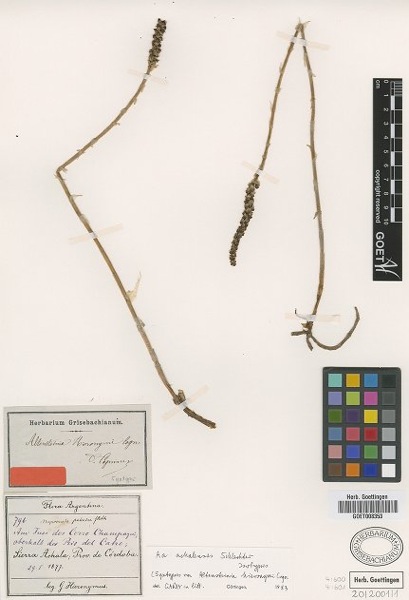 Somehow I get the feeling that botanists haven't got the "open data" religion. Not only is the list of plant names list behind a really bad license, but the Global Plants Initiative (GPI) hides its type images behind a JSTOR Plant Sciences paywall. Why is botany determined to keep its data under wraps?
Somehow I get the feeling that botanists haven't got the "open data" religion. Not only is the list of plant names list behind a really bad license, but the Global Plants Initiative (GPI) hides its type images behind a JSTOR Plant Sciences paywall. Why is botany determined to keep its data under wraps?For example, the first specimen on the JSTOR site is the GOET008353, the isotype of Aa achalensis Schltr.. You can see a thumbnail of the specimen (shown on the right), but if you want the full image you need to have a subscription, otherwise you see this message:
The resource you are attempting to access is part of JSTOR Plant Science. JSTOR Plant Science is currently being offered free of charge for all JSTOR participants and not for profit institutions. To learn more about JSTOR Plant Science, please contact plants@jstor.org.
So, without a subscription you don't get to see this in high resolution (the JSTOR site features a higher resolution image and associated viewer):

Why would herbariums hand over this imagery? I complained about this on Facebook and Chuck Miller responded that the original herbaria retain control over the images, so they aren't locked away. However, I then when to the herbarium that has this specimen (the Type Database of Herbarium Göttingen (GOET) and search for this specimen I eventually find it listed as 4966. There is no image!
So, the only place I can see this image is on JSTOR, for which I need a subscription. I'm also puzzled by the fact that JSTOR refers to this as "GOET008353", whereas the original herbarium refers to it as "4966". GBIF also has this specimen, which it refers to as GOET GOET-Typen 4966. The GOET008353 is a barcode given to types as part of the GPI digitisation programme. Unfortunately, neither the originating herbarium nor GBIF seems to know about this.
In summary, we have three databases with data on this specimen, each with a different specimen identifier, none of which link to each other, and the available imagery is behind a paywall.
Clearly botany hasn't gotten the memo about open data...